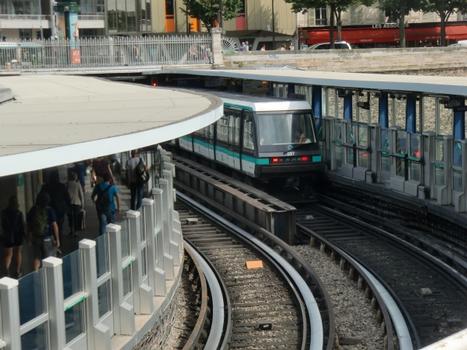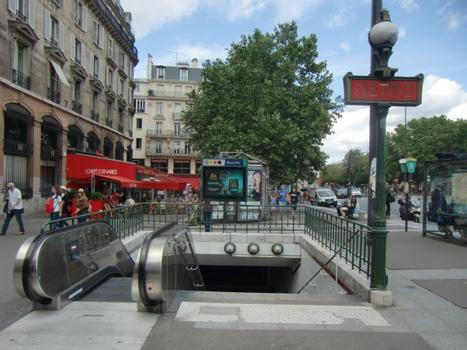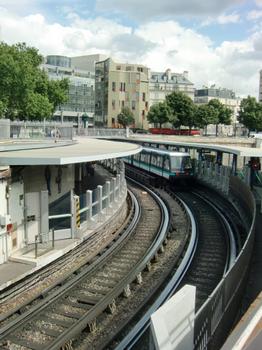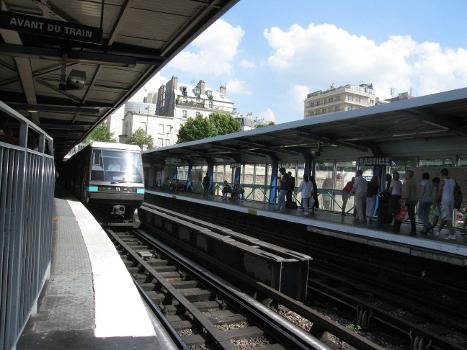General Information
| Completion: | 19 July 1900 |
|---|---|
| Status: | in use |
Project Type
| Function / usage: |
Below grade metro or light-rail station |
|---|---|
| Structure: |
Underground structure |
Location
| Location: |
Paris ( 4th), Paris, Ile-de-France, France Paris (11th), Paris, Ile-de-France, France Paris (12th), Paris, Ile-de-France, France |
|---|---|
| Part of: | |
| Coordinates: | 48° 51' 11.16" N 2° 22' 8.69" E |
Technical Information
There currently is no technical data available.
Excerpt from Wikipedia
Bastille (French pronunciation: [bastij] (listen)) is a station on lines 1, 5 and 8 of the Paris Métro. It is located near the Bastille Square and former location of the Bastille and is located on the border of the 4th, 11th and 12th arrondissements of Paris.
Location
The station is located on Place de la Bastille, the platform being established:
- Line 1, south of the square, outside the Canal Saint-Martin (between Saint-Paul and Gare de Lyon stations);
- Line 5, west of the square between Boulevard Richard-Lenoir and Boulevard Bourdon (between Bréguet-Sabin and Quai de la Rapée stations, not including the Arsenal ghost station);
- Line 8, north of the square between Boulevard Beaumarchais and Rue du Faubourg-Saint-Antoine (between Chemin Vert and Ledru-Rollin stations).
History
The Line 1 station opened as part of the first stage of the line between Porte de Vincennes and Porte Maillot on 19 July 1900.
It derives its name from the Place de la Bastille, symbolic place of the French Revolution, where the old fortress of the Bastille was destroyed between 14 July 1789 and 14 July 1790.
On 17 December 1906, the station of Line 5 was opened when the line was extended from Gare de Lyon to Lancry (now known as Jacques Bonsergent). The Line 8 platforms were opened on 5 May 1931 when the line was extended from Richelieu – Drouot to Porte de Charenton.
During the 1960s, the platform of Line 5 were renovated in the Mouton-Duvernet style with two-tone orange-tinted ceramic tiles, a white painted vault and characteristic lighting strips. Subsequently, they were equipped with seats Motte orange.
The platforms of Line 1 have been upgraded as part of its full automation. They are the last to be equipped with landing doors, in April 2011, because of the technical difficulty that constituted the curve pronounced at their western end.
It saw 13,172,392 passengers enter in 2018, which places its attendance at the 10th position of all metro stations.
Services for passengers
Access
The station has nine accesses from Place de la Bastille:
- Boulevard Henri-IV;
- Boulevard Bourdon;
- Rue de Lyon;
- Boulevard de la Bastille;
- Opera Bastille;
- Jardin du Port-de-l'Arsenal;
- Hospital Quinze-Vingts;
- Rue de la Roquette;
- Rue du Faubourg-Saint-Antoine.
The access leading to the Rue de Lyon was decorated with a Hector Guimard designed entrance registered as a historic monument on 29 May 1978. However, it was later moved to a metro station Boulevard Beaumarchais.
Platforms
The platforms of the three lines are of standard configuration. Two at each stop point, they are separated by the metro tracks in the centre.
The platforms of Line 1 are very particular for more than one reason, the station of this line is established on a very tight curve and counter curve, partly underground and part above ground. The western end of the line 1 platforms have the sharpest curve used by passenger trains on the Métro, with a radius of only 40 metres (131 ft). The line 1 platforms, at 123 metres (404 ft) long, are significantly longer than the average Métro platform length. The latter part overlooks the Canal Saint-Martin that, at this point, passes from being underground to open air. Finally, the tracks and platforms are partly sloped. The ceiling of the subterranean part, built on the surface of the ground, consists of a metal deck, the silver beams are supported by vertical walls. The decoration of these walls and spandrels is "cultural" evoking the French Revolution thanks to a unique ceramics created by Liliane Belembert and Odile Jacquot in May 1989. Part of this fresco was replaced by a plastic display on automation of the line on the occasion of this operation (platform direction La Défense). The open-air part of the platform towards Château de Vincennes has floor-to-ceiling windows offering a view of the Saint-Martin canal opening onto the port of Arsenal. Bevelled white ceramic tiles cover only the outlets of the corridors. The name of the station is written in Parisine typeface on enamelled plates. The platforms, equipped with glass edge doors, are devoid of advertisements and seats.
The platforms of Line 5 are underground and have an elliptical vault. The decoration is the style used for the majority of metro stations. The lighting strips are white and rounded in the Gaudin style of l'Operation Espace Métro 2000, and the white ceramic tiles are covered the walls, the vault, the spandrels and the outlets of the corridors. The advertising frames are of white ceramics and the name of the station is written in Parisine typeface on enamelled plates. The seats, style Akiko, are burgundy. Foundations of one of the counterscarp walls of the old Bastille prison, discovered during the construction of the line in 1905, are visible on the platform in the direction of Bobigny-Pablo Picasso. Metal lines drawn on the ground mark the contours of the building on the two platforms. The station also exhibits various views of the ancient fortress.
The platforms of Line 8 are also underground under an elliptical vault. They are furnished in the Andreu-Motte style with two orange luminous ramps, benches and outlets in the corridors treated with flat brown tiles and Motte orange seats. These arrangements are married with the flat white ceramic tiles that cover the walls, vault and spandrels, making this station one of the few to have the Andreu-Motte preserved style. Advertising frames are metallic and the name of the station is Parisine typeface on enamelled plates. The station is distinguished however by the lower part of its walls which are vertical and not elliptical.
Text imported from Wikipedia article "Bastille (Paris Métro)" and modified on July 23, 2019 according to the CC-BY-SA 4.0 International license.
Participants
Currently there is no information available about persons or companies having participated in this project.
Relevant Web Sites
- About this
data sheet - Structure-ID
20051471 - Published on:
08/01/2010 - Last updated on:
25/01/2022









